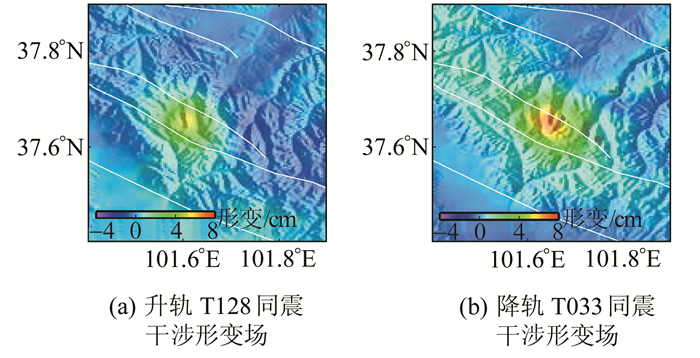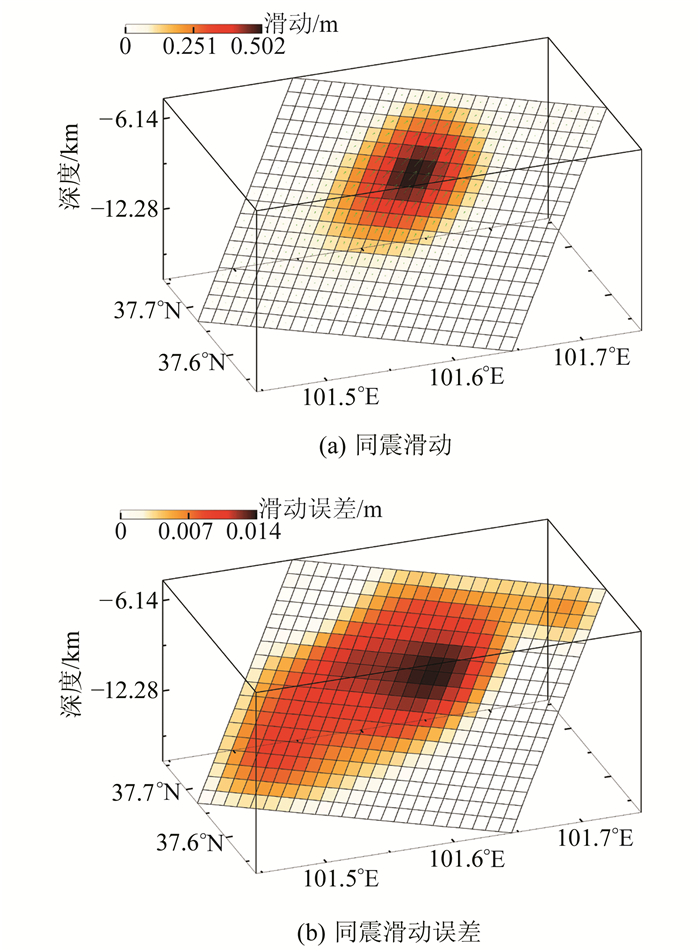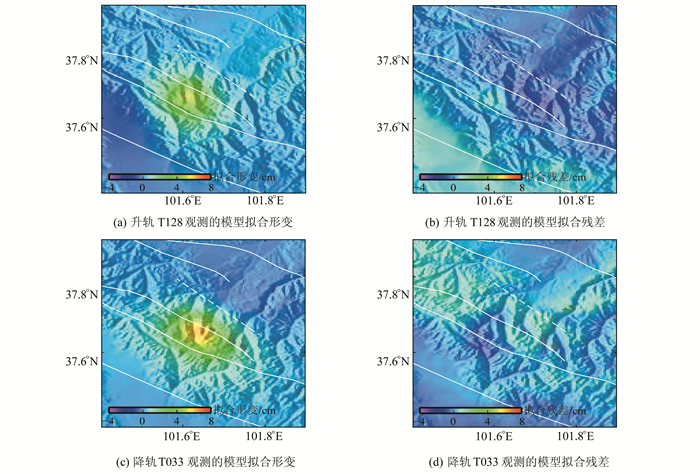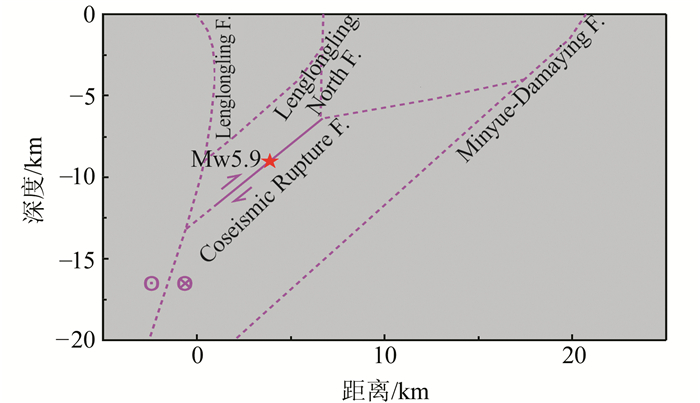InSAR Observation of Menyuan Mw5.9 Earthquake Deformation and Deep Geometry of Regional Fault Zone
-
摘要: 利用Sentinel-1A卫星升轨、降轨合成孔径雷达影像数据,提取了2016年门源Mw5.9级地震的高精度合成孔径雷达干涉同震形变场,利用单纯形法和非负最小二乘法反演确定了地震断层几何和滑动分布,并构建了区域断裂带的深部几何形态模型。结果表明,门源Mw5.9级地震同震形变以地表抬升为主,沿升轨、降轨视线向的最大值分别为5.3 cm、7.1 cm;地震断层走向、倾角分别为133°、43°;地震滑动以逆冲为主,主要发生在地下6.14~12.28 km处,最大滑动量约0.5 m,平均滑动角为66.85°,地震矩为1.0×1018 N·m(Mw5.94);形变观测拟合残差均方根为0.36 cm;区域断裂带的深部几何形态以花状构造为特征,整体倾向南西,门源地震发震断裂为花状构造中未出露地表的盲断层。相关成果能够为研究区域地壳运动与变形、活动断裂与地震孕育发生等提供参考。
-
关键词:
- 门源Mw5.9级地震 /
- InSAR /
- 滑动分布 /
- 深部几何形态 /
- 花状构造
Abstract: By using Sentinel-1A ascending and descending synthetic aperture radar (SAR) data, this paper extracts the high-precision interferometric SAR (InSAR) coseismic deformation of the 2016 Menyuan Mw5.9 earthquake, inverts the fault geometry and slip distribution using simplex method and nonnegative least squares method, and constructs the deep geometry model of regional fault zone. The results show that coseismic deformation of the Menyuan Mw5.9 earthquake is dominated by surface uplift, and the maximums along the line-of-sight direction of ascending and descending tracks are 5.3 cm and 7.1 cm respectively. The fault strike and dip angles are 133° and 43° respectively. The seismic slip is dominated by thrust component, mainly occurring in 6.14-12.28 km underground. The maximum slip is about 0.5 m, the average slip angle is 66.85°, and the earthquake moment is 1.0×1018 N·m (Mw5.94). The fitting residual root mean square of deformation observations is 0.36 cm. The deep geometry of the regional fault zone is characterized by flower structure, which inclines to the south-west as a whole. The Menyuan earthquake rupture is a blind fault which does not appear on the surface in the flower structure. Relevant results can provide the reference for studying regional crustal movement and deformation, active fault and earthquake preparation and occurrence.-
Keywords:
- Menyuan Mw5.9 earthquake /
- InSAR /
- slip distribution /
- deep geometry /
- flower structure
-
-
表 1 2016年门源Mw5.9级地震断层参数
Table 1 Fault Parameters of the 2016 Menyuan Mw5.9 Earthquake
数据来源 震中位置 长度/km 顶深/底深/km 走向/倾角 滑动角/滑动量 震级 CENC 101.62°E,37.68°N - - 143°/35° 80°/- M6.4 IGP-CEA 101.6°E,37.7°N - - 141°/38° 79°/- Ms6.4 USGS 101.641°E,37.67°N - - 144°/36° 75°/- Mw5.9 GCMT 101.76°E,37.65°N - - 134°/43° 68°/- Mw5.9 文献[6] 101.65°E,37.64°N 20 7.29/13.71 134°/40° 65°/- Mw5.9 文献[7] - - - 128°/43° 78°/- Mw5.9 文献[8] 101.61°E,37.67°N - - 335°/~75° 97°/- - 文献[9] 101.69°E,37.66°N 10.2 6.17/9.63 130°/46° 47°/0.6 m Mw5.9 文献[11] 101.623°E,37.657°N 3.5 7.94/10.06 127°/45° 73°/2.256 m Mw5.891 文献[12] 101.621°E,37.66°N 16 6.37/13.59 132°/41° 68°/0.41 m Mw5.905 本研究 101.69°E,37.72°N 9.12 6.40/11.64 133°/43° 65.66°/0.40 m Mw5.9 表 2 Sentinel-1A干涉像对参数
Table 2 Parameters of Sentinel-1A Interferometric Image Pair
序号 轨道 飞行方向 获取时间 时间基线/d 空间基线/m 主影像 辅影像 1 128 升轨 2016-01-13 2016-02-06 24 15 2 033 降轨 2016-01-18 2016-02-11 24 6.5 -
[1] 何文贵, 刘百篪, 袁道阳, 等.冷龙岭活动断裂的滑动速率研究[J].西北地震学报, 2000, 22(1): 90-97 doi: 10.3969/j.issn.1000-0844.2000.01.017 He Wengui, Liu Baichi, Yuan Daoyang, et al. Research on Slip Rates of the Lenglongling Active Fault Zone[J].Northewestern Seismological Journal, 2000, 22(1): 90-97 doi: 10.3969/j.issn.1000-0844.2000.01.017
[2] 邓起东, 张培震, 冉勇康, 等.中国活动构造基本特征[J].中国科学(D辑), 2002, 32(12): 1 020-1 031 http://d.old.wanfangdata.com.cn/Periodical/zgkx-cd200212007 Deng Qidong, Zhang Peizhen, Ran Yongkang, et al. Basic Characteristics of Active Tectonics of China[J].Science in China(Series D), 2002, 32(12): 1 020-1 031 http://d.old.wanfangdata.com.cn/Periodical/zgkx-cd200212007
[3] 胡朝忠, 杨攀新, 李智敏, 等. 2016年1月21日青海门源6.4级地震的发震机制探讨[J].地球物理学报, 2016, 59(5): 1 637-1 646 http://www.wanfangdata.com.cn/details/detail.do?_type=perio&id=dqwlxb201605009 Hu Chaozhong, Yang Panxin, Li Zhimin, et al. Seismogenic Mechanism of the 21 January 2016 Menyuan, Qinghai Ms6.4 Earthquake[J].Chinese Journal of Geophysics, 2016, 59(5): 1 637-1 646 http://www.wanfangdata.com.cn/details/detail.do?_type=perio&id=dqwlxb201605009
[4] 郭鹏, 韩竹军, 安艳芬, 等.冷龙岭断裂系活动性与2016年门源6.4级地震构造研究[J].中国科学:地球科学, 2017, 47(5): 617-630 http://www.wanfangdata.com.cn/details/detail.do?_type=perio&id=zgkx-cd201705009 Guo Peng, Han Zhujun, An Yanfen, et al. Activity of the Lenglongling Fault System and Seismotecto-nics of the 2016 Ms6.4 Menyuan Earthquake[J].Science China Earth Sciences, 2017, 47(5): 617-630 http://www.wanfangdata.com.cn/details/detail.do?_type=perio&id=zgkx-cd201705009
[5] 姜文亮, 李永生, 田云锋, 等.冷龙岭地区2016年青海门源6.4级地震发震构造特征[J].地震地质, 2017, 39(3): 536-549 doi: 10.3969/j.issn.0253-4967.2017.03.007 Jiang Wenliang, Li Yongsheng, Tian Yunfeng, et al. Research of Seismogenic Structure of the Men-yuan Ms6.4 Earthquake on January 21, 2016 in Lenglongling Area of the NE Tibetan Plateau[J].Seismology and Geology, 2017, 39(3): 536-549 doi: 10.3969/j.issn.0253-4967.2017.03.007
[6] Li Y, Jiang W, Zhang J, et al. Space Geodetic Observations and Modeling of 2016 Mw5.9 Menyuan Earthquake: Implications on Seismogenic Tectonic Motion[J]. Remote Sensing, 2016, 8(6): 519 doi: 10.3390/rs8060519
[7] 郑博文. 2016年门源地震InSAR形变场及发震断层参数反演[D].北京: 中国地震局地质研究所, 2017 http://cdmd.cnki.com.cn/Article/CDMD-85402-1017283288.htm Zheng Bowen. Fault Slip Inversion of 2016 Men-yuan Earthquake from InSAR Deformation Fields by Multi-orbit Sentinel-1A Images[D]. Beijing: Institude of Geology, China Earthquake Administration, 2017 http://cdmd.cnki.com.cn/Article/CDMD-85402-1017283288.htm
[8] 黄浩, 付虹, 沙成宁, 等. 2016年青海门源Ms6.4地震重定位[J].地震学报, 2017, 39(2): 176-187 http://d.old.wanfangdata.com.cn/Periodical/dizhen201702002 Huang Hao, Fu Hong, Sha Chengning, et al. Relocation of the 2016 Ms6.4 Men-yuan, Qinghai Earthquake[J].Acta Seismologica Sinica, 2017, 39(2): 176-187 http://d.old.wanfangdata.com.cn/Periodical/dizhen201702002
[9] 张明, 高涵, 牛玉芬, 等. 2016年门源地震震源机制DInSAR同震形变反演[J].地球物理学进展, 2017, 32(3): 1 089-1 094 http://www.wanfangdata.com.cn/details/detail.do?_type=perio&id=dqwlxjz201703019 Zhang Ming, Gao Han, Niu Yufen, et al. Coseismic Deformation Focal Mechanisms Inversion for 2016 Menyuan Earthquake by DInSAR Observations[J].Progress in Geophysics, 2017, 32(3): 1 089-1 094 http://www.wanfangdata.com.cn/details/detail.do?_type=perio&id=dqwlxjz201703019
[10] 雷东宁, 刘杰, 刘姝妹, 等. 2016年1月21日青海门源M 6.4地震发震构造模式[J].地震地质, 2018, 40(1): 107-120 doi: 10.3969/j.issn.0253-4967.2018.01.009 Lei Dongning, Liu Jie, Liu Shumei, et al. Discussion on the Seismogenic Structure of the 2016 Men-yuan M 6.4 Earthquake in Menyuan, Qinghai[J].Seismology and Geology, 2018, 40(1): 107-120 doi: 10.3969/j.issn.0253-4967.2018.01.009
[11] Wang H, Liu-Zeng J, Ng A H M, et al. Sentinel-1 Observations of the 2016 Menyuan Earthquake: A Buried Reverse Event Linked to the Left-Lateral Haiyuan Fault[J]. International Journal of Applied Earth Observation and Geoinformation, 2017, 61: 14-21 doi: 10.1016/j.jag.2017.04.011
[12] Xiong W, Chen W, Zhao B, et al. Insight into the 2016 Menyuan Mw5.9 Earthquake with InSAR: A Blind Reverse Event Promoted by Historical Earthquakes[J]. Pure and Applied Geophysics, 2019, 176: 577-591 doi: 10.1007/s00024-018-2000-0
[13] Wright T J, Lu Z, Wicks C. Source Model for the Mw6.7, 23 October 2002, Nenana Mountain Earthquake (Alaska) from InSAR[J]. Geophysical Research Letters, 2003, 30(18): 1 974 http://cn.bing.com/academic/profile?id=61705caed5a624908719f664363be939&encoded=0&v=paper_preview&mkt=zh-cn
[14] Li Z, Elliott J R, Feng W, et al. The 2010 Mw6.8 Yushu (Qinghai, China) Earthquake: Constraints Provided by InSAR and Body Wave Seismology[J]. Journal of Geophysical Research, 2011, 116(B10): B10302 doi: 10.1029/2011JB008358
[15] Weston J, Ferreira A M, Funning G J. Systematic Comparisons of Earthquake Source Models Determined Using InSAR and Seismic Data[J]. Tectonophysics, 2012, 532-535: 61-81 doi: 10.1016/j.tecto.2012.02.001
[16] 刘洋, 许才军, 温扬茂, 等. 2008年大柴旦Mw6.3级地震的InSAR同震形变观测及断层参数反演[J].测绘学报, 2015, 44(11): 1 202-1 209 http://d.old.wanfangdata.com.cn/Periodical/chxb201511006 Liu Yang, Xu Caijun, Wen Yangmao, et al. The InSAR Coseismic Deformation Observations and Fault Parameter Inversion of the 2008 Dachaidan Mw6.3 Earthquake[J].Acta Geodaetica et Cartographica Sinica, 2015, 44(11): 1 202-1 209 http://d.old.wanfangdata.com.cn/Periodical/chxb201511006
[17] 许才军, 邓长勇, 周力璇.利用方差分量估计的地震同震滑动分布反演[J].武汉大学学报·信息科学版, 2016, 41(1): 37-44 http://ch.whu.edu.cn/CN/abstract/abstract3431.shtml Xu Caijun, Deng Changyong, Zhou Lixuan. Coseismic Slip Distribution Inversion Method Based on the Variance Component Estimation[J].Geomatics and Information Science of Wuhan University, 2016, 41(1): 37-44 http://ch.whu.edu.cn/CN/abstract/abstract3431.shtml
[18] 温扬茂, 冯怡婷.地震破裂模型约束的中国阿里地震三维形变场[J].武汉大学学报·信息科学版, 2018, 43(9): 1 369-1 375 http://ch.whu.edu.cn/CN/abstract/abstract6199.shtml Wen Yangmao, Feng Yiting. Three-Dimensional Deformation Field of Ali Earthquake from InSAR Observations and Earthquake Rupture Model[J].Geomatics and Information Science of Wuhan University, 2018, 43(9): 1 369-1 375 http://ch.whu.edu.cn/CN/abstract/abstract6199.shtml
[19] Lawson C L, Hanson R J. Solving Least Squares Problems[J]. International Journal of Computer Mathematics, 1995, 77: 105-116 http://d.old.wanfangdata.com.cn/Periodical/yysxhlx-e201203009
[20] 苏小宁, 王振, 孟国杰, 等. GPS观测的2015年尼泊尔Ms8.1级地震震前应变积累及同震变形特征[J].科学通报, 2015, 60(22): 2 115-2 123 http://www.wanfangdata.com.cn/details/detail.do?_type=perio&id=kxtb201522007 Su Xiaoning, Wang Zhen, Meng Guojie, et al. Pre-seismic Strain Accumulation and Co-seismic Deformation of the 2015 Nepal Ms8.1 Earthquake Observed by GPS[J].China Science Bulletin, 2015, 60(22): 2 115-2 123 http://www.wanfangdata.com.cn/details/detail.do?_type=perio&id=kxtb201522007
[21] Werner C, Wegmüller U, Strozzi T, et al. Gamma SAR and Interferometric Processing Software[C]. ERS-ENVISAT Symposium, Gothenburg, Sweden, 2000 https://wenku.baidu.com/view/ffb48a0af78a6529647d5354.html
[22] Farr T G, Rosen P A, Caro E, et al. The Shuttle Radar Topography Mission[J]. Reviews of Geophysics, 2007, 45: RG2004 http://d.old.wanfangdata.com.cn/OAPaper/oai_doaj-articles_dcbab017f5e8e5b8ef41432c8377aabd
[23] Goldstein R M, Werner C L. Radar Interferogram Filtering for Geophysical Applications[J]. Geophysical Research Letters, 1998, 25(21): 4 035-4 038 doi: 10.1029/1998GL900033
[24] Goldstein R, Zebker H, Werner C. Satellite Radar Interferometry: Two-Dimensional Phase Unwrapping[J].Radio Science, 1988, 23(4): 713-720 doi: 10.1029/RS023i004p00713
[25] Jónsson S, Zebker H, Segall P, et al. Fault Slip Distribution of the 1999 Mw7.1 Hector Mine, California, Earthquake, Estimated from Satellite Radar and GPS Measurements[J]. Bulletin of the Seismological Society of America, 2002, 92(4): 1 377-1 389 doi: 10.1785/0120000922
[26] Okada Y. Surface Deformation Due to Shear and Tensile Faults in a Half-Space[J]. Bulletin of the Seismological Society of America, 1985, 75(4): 1 135-1 154 http://cn.bing.com/academic/profile?id=819f2a013c19c9434aaefa8e5bcb6ba5&encoded=0&v=paper_preview&mkt=zh-cn
[27] Xu C, Liu Y, Wen Y, et al. Coseismic Slip Distribution of the 2008 Mw7.9 Wenchuan Earthquake from Joint Inversion of GPS and InSAR Data[J]. Bulletin of the Seismological Society of America, 2010, 100(5B): 2 736-2 749 doi: 10.1785/0120090253
[28] 陈文彬.河西走廊及邻近地区最新构造变形基本特征及构造成因分析[D].北京: 中国地震局地质研究所, 2003 http://cdmd.cnki.com.cn/Article/CDMD-85402-2004096204.htm Chen Wenbin. Principal Features of Tectonic Deformation and Their Generation Mechanism in the Hexi Corridor and Its Adjacent Regions Since Late Quaternary[D]. Beijing: Institude of Geology, China Earthquake Administration, 2003 http://cdmd.cnki.com.cn/Article/CDMD-85402-2004096204.htm
-
期刊类型引用(46)
1. 刘春雷,张媛静,陆晨明,李亚松,李剑锋. 基于时序InSAR的九龙江河口地区地面沉降时空演变规律及成因分析. 应用海洋学学报. 2024(01): 116-125 .  百度学术
百度学术
2. 陈瑞瑞,孙颢月,朱紫若,蒋雪中,陈沈良,陈静. 黄河三角洲地面沉降研究进展与未来展望. 海岸工程. 2024(01): 1-23 .  百度学术
百度学术
3. 赵凤阳,周吕,魏玉业. 融合改进鲸鱼算法解缠的梧州市地面沉降InSAR监测. 遥感信息. 2024(01): 52-58 .  百度学术
百度学术
4. 侯永浩,张兴,李晓民,李宗仁. SBAS-InSAR技术在地质灾害调查中的应用. 北京测绘. 2024(10): 1477-1481 .  百度学术
百度学术
5. 柳新强,姜刚,刘军峰,贺国伟. PS-InSAR和SBAS-InSAR的地表沉降监测对比研究——以雄安新区为例. 工程勘察. 2023(01): 62-67 .  百度学术
百度学术
6. 曾敏,皮鹏程,赵信文,陈松,彭红霞,侯清芹,孙慧敏,薛紫萱. 基于PS-InSAR的珠江口典型填海造地区地面沉降时空特征研究. 华南地质. 2023(01): 116-126 .  百度学术
百度学术
7. 李文慧,王志伟,赵月,王翔. 基于SNAP-StaMPS方法的高速公路沿线地面沉降监测. 测绘工程. 2023(03): 36-43 .  百度学术
百度学术
8. 周定义,左小清,赵志芳,喜文飞,葛楚. 基于SBAS-InSAR和改进BP神经网络的城市地面沉降预测. 地质通报. 2023(10): 1774-1783 .  百度学术
百度学术
9. 刘泽洲,卢才武,章赛,李萌,和郑翔. 基于多阈值目标提取的时序InSAR矿区地表沉降监测研究. 中国矿业. 2022(08): 79-85 .  百度学术
百度学术
10. 王新田,刘增珉,陈建忠,梁菲,孟萌,李天鹤. 山东省地表形变InSAR监测与分析. 测绘通报. 2022(S2): 130-134 .  百度学术
百度学术
11. 邓晓景,曲国庆,张建霞,席换,王晖. 融合升降轨PS-InSAR东营市地面沉降监测. 山东理工大学学报(自然科学版). 2021(01): 10-16 .  百度学术
百度学术
12. 杨利,薛东剑,王海方,付林,张婷. 五龙沟矿区时序InSAR地表形变监测. 中国矿业. 2021(03): 107-112 .  百度学术
百度学术
13. 程琳琳,杨玉曼,李月颖,孙梦尧,王振威,焦路尧. 矿业型村镇转型期发展问题分析与策略研究:以北京市门头沟区为例. 中国矿业. 2021(03): 101-106 .  百度学术
百度学术
14. 王辉,曾琪明,焦健,陈继伟. 结合序贯平差方法监测地表形变的InSAR时序分析技术. 北京大学学报(自然科学版). 2021(02): 241-249 .  百度学术
百度学术
15. 付云霞,管勇,王晓丹,王建收,尹政,周晓雪,王青,徐美君. 大型河口三角洲地面沉降机制研究——以黄河三角洲为例. 海岸工程. 2021(02): 83-95 .  百度学术
百度学术
16. 关金环,高明亮,宫辉力. 首都国际机场区域差异性沉降原因探讨. 测绘科学. 2021(09): 67-75 .  百度学术
百度学术
17. 柴华彬,胡吉彪,耿思佳. 融合实测数据的地表沉降SBAS-InSAR监测方法. 煤炭学报. 2021(S1): 17-24 .  百度学术
百度学术
18. 程霞,张永红,邓敏,吴宏安,康永辉. Sentinel-1A卫星的黄河三角洲近期地表形变分析. 测绘科学. 2020(02): 43-51 .  百度学术
百度学术
19. 卢旺达,韩春明,岳昔娟,赵迎辉,周格仪. 基于Sentinel-1A数据的天津地区PS-InSAR地面沉降监测与分析. 遥感技术与应用. 2020(02): 416-423 .  百度学术
百度学术
20. 向淇文,潘建平,张广泽,徐正宣,张定凯,涂文丽. 基于SBAS技术的川藏铁路折多山地区地表形变监测与分析. 测绘工程. 2020(04): 48-54+59 .  百度学术
百度学术
21. 张金盈,崔靓,刘增珉,王新田,林琳,徐凤玲. 利用Sentinel-1 SAR数据及SBAS技术的大区域地表形变监测. 测绘通报. 2020(07): 125-129 .  百度学术
百度学术
22. 狄桂栓. 基于InSAR技术的黄河三角洲区域地表形变浅析. 地理空间信息. 2020(09): 106-109+8 .  百度学术
百度学术
23. 高辉,罗孝文,吴自银,阳凡林. 基于时序InSAR的珠江口大面积地面沉降监测. 海洋学研究. 2020(02): 81-87 .  百度学术
百度学术
24. 韩红花. 黄河三角洲区域地表形变监测研究. 山东国土资源. 2020(11): 69-72 .  百度学术
百度学术
25. 夏元平,陈志轩,张毅. 南昌市地面沉降InSAR监测及影响因子分析. 测绘科学. 2020(11): 115-122+129 .  百度学术
百度学术
26. 贺跃光,肖亮. 某水溶开采矿区短基线集InSAR高相干点探测. 中国锰业. 2019(01): 89-93 .  百度学术
百度学术
27. 张静,丁黄平,刘纯,谢文然,时雨. 基于InSAR技术的盘锦地区地面沉降研究. 世界地质. 2019(02): 574-580 .  百度学术
百度学术
28. 韩红超,符华年,张文峰,温浩. InSAR、水准多维沉降监测体系建设及应用研究. 测绘通报. 2019(S1): 236-241 .  百度学术
百度学术
29. 师芸,李伟轩,唐亚明,席磊,孟欣. 时序InSAR技术在地球环境监测及其资源管理中的应用:以交城-清徐地区为例. 武汉大学学报(信息科学版). 2019(11): 1613-1621 .  百度学术
百度学术
30. 杨帆,王道顺,张磊,张子文. 基于时序InSAR的隧道工程形变监测与分析. 测绘与空间地理信息. 2019(10): 1-4 .  百度学术
百度学术
31. 黄洁慧,谢谟文,王立伟. 基于SBAS-InSAR技术的白格滑坡形变监测研究. 人民长江. 2019(12): 101-105 .  百度学术
百度学术
32. 黄洁慧,谢谟文,王立伟. 基于差分干涉合成孔径雷达技术的米林滑坡形变监测. 科学技术与工程. 2019(25): 7-12 .  百度学术
百度学术
33. 李锁乐,吴宏安,张永红,康永辉,左振华. 包头市地面沉降高分辨率时序InSAR监测. 测绘科学. 2018(09): 76-80 .  百度学术
百度学术
34. 杨帆,张磊,张子文,赵增鹏. 利用短基线集InSAR技术监测抚顺市地面沉降. 测绘通报. 2018(03): 84-88 .  百度学术
百度学术
35. 张静,冯东向,綦巍,周雪,赵玉星. 基于SBAS-InSAR技术的盘锦地区地面沉降监测. 工程地质学报. 2018(04): 999-1007 .  百度学术
百度学术
36. 贺晓阳,赵盟,程存付. 小基线集技术在矿区地表形变监测中的应用. 河南科技. 2018(13): 97-98 .  百度学术
百度学术
37. LIU Xiao,LIU Jie,FENG Xiuli. Inversion and Prediction of Consolidation Settlement Characteristics of the Fluvial Sediments Based on Void Ratio Variation in the Northern Modern Yellow River Subaqueous Delta, China. Journal of Ocean University of China. 2018(03): 545-554 .  必应学术
必应学术
38. 李达,邓喀中,高晓雄,牛海鹏. 基于SBAS-InSAR的矿区地表沉降监测与分析. 武汉大学学报(信息科学版). 2018(10): 1531-1537 .  百度学术
百度学术
39. 张炜,张伟胜,张东升,胡文敏,孙毓言,唐佳佳. 采动覆岩活动规律的“空-地”监测技术. 中国矿业大学学报. 2018(06): 1212-1223 .  百度学术
百度学术
40. 王小侣. 水电站大坝400V备自投改造研究. 河南科技. 2018(19): 90-91 .  百度学术
百度学术
41. 张磊,杨帆,李超飞,赵增鹏,张子文. 宁波地面沉降的短基线集监测与分析. 测绘科学. 2017(12): 77-82 .  百度学术
百度学术
42. 陈继伟,曾琪明,焦健,赵斌臣. Sentinel-1A卫星TOPS模式数据的SBAS时序分析方法——以黄河三角洲地区为例. 国土资源遥感. 2017(04): 82-87 .  百度学术
百度学术
43. 王萍. 沉降观测技术在高层建筑施工中的应用. 建材与装饰. 2017(35): 19-20 .  百度学术
百度学术
44. 史秀保,徐宁,温浩,李春进. 一种小基线地表形变监测精度评价方法. 测绘通报. 2016(08): 70-73+91 .  百度学术
百度学术
45. 于丹,杨子玉,庄岩,于均园. 时序分析法在沈阳地铁二号线变形预测的应用. 沈阳建筑大学学报(自然科学版). 2016(03): 453-458 .  百度学术
百度学术
46. 王霖郁,李辉. 一种枝切法和质量图相结合的InSAR相位解缠算法. 应用科技. 2016(05): 49-53 .  百度学术
百度学术
其他类型引用(25)





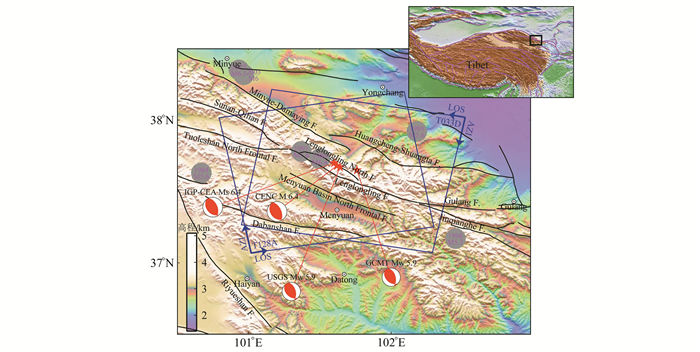
 下载:
下载:
